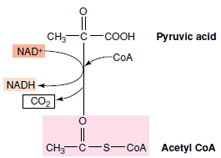Acetyl Coenzyme A: Strategic Intermediate in Respiration
In aerobic metabolism the two molecules of pyruvic acid formed during glycolysis enter a mitochondrion. There, each molecule is oxidized, and one of the carbons is released as carbon dioxide (Figure 4-12). The 2-carbon residue condenses with coenzyme A to form acetyl coenzyme A (acetyl-CoA).
Pyruvic acid is the undissociated form of the acid . Under physiological conditions pyruvic acid typically dissociates into pyruvaye
. Under physiological conditions pyruvic acid typically dissociates into pyruvaye  and H+. It is correct to use either term in describing this and other organic acids (such as lactic acid, or lactate) in metabolism.
and H+. It is correct to use either term in describing this and other organic acids (such as lactic acid, or lactate) in metabolism.
Acetyl coenzyme A is a critically important compound. Its oxidation in the Krebs cycle (following) provides energized electrons to generate ATP, and it is a crucial intermediate in lipid metabolism.
Pyruvic acid is the undissociated form of the acid
 . Under physiological conditions pyruvic acid typically dissociates into pyruvaye
. Under physiological conditions pyruvic acid typically dissociates into pyruvaye  and H+. It is correct to use either term in describing this and other organic acids (such as lactic acid, or lactate) in metabolism.
and H+. It is correct to use either term in describing this and other organic acids (such as lactic acid, or lactate) in metabolism.
Acetyl coenzyme A is a critically important compound. Its oxidation in the Krebs cycle (following) provides energized electrons to generate ATP, and it is a crucial intermediate in lipid metabolism.





